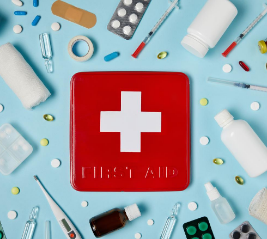How many times have you been skipping through the park, stubbed your toe and wished you had a first aid kit? Been home, sliced your finger on a knife but had no bandaids? You aren’t alone. There are so many options for what you may want to have on hand in a first aid kit. Let’s review which supplies are good to have and what to think about when getting your kit ready.
First, keep in mind that a first aid kit for home and light travel should have basic items, but if you are headed out camping or on an adventure where there is no access to healthcare or emergency care, you may want to be sure you do some research and have more options available.
What should a basic first aid kit contain?
A first aid kit should be well marked and in a known location. Keep one in the car that you can grab and throw into a backpack or stroller for when you are on an excursion. You can purchase a pre-packaged kit and add to it as needed. You can find some kits come with all you may need and more!
The American Red Cross suggests this list for a family of 4:
- 2 absorbent compress dressings (5 x 9 inches)
- 25 adhesive bandages (assorted sizes)
- 1 adhesive cloth tape (10 yards x 1 inch)
- 5 antibiotic ointment packets (approximately 1 gram)
- 5 antiseptic wipe packets
- 2 packets of aspirin (81 mg each)
- 1 emergency blanket
- 1 breathing barrier (with one-way valve)
- 1 instant cold compress
- 2 pair of non-latex gloves (size: large)
- 2 hydrocortisone ointment packets (approximately 1 gram each)
- 1 3 in. gauze roll (roller) bandage
- 1 roller bandage (4 inches wide)
- 5 3 in. x 3 in. sterile gauze pads
- 5 sterile gauze pads (4 x 4 inches)
- Oral thermometer (non-mercury/non-glass)
- 2 triangular bandages
- Tweezers
- Emergency First Aid guide
What’s in a first aid kit?

This list seems long, but each item has a purpose. You want to have something to stop minor bleeding and cover up a cut or laceration. Check your kit to be sure it includes a few gauze bandages, bandaids in a few shapes and sizes and some paper tape to wrap up cuts and scrapes as needed. A longer roll of gauze can come in handy with a larger bleed or to cover a large scrape.
The next thing you want to think about is having some ointments and creams for the more common issues you may face. Having some single use packs or small tubes of over-the-counter items such as burn ointment (for minor burns), triple antibiotic ointment (for cuts and scrapes), hydrocortisone (for itchy bug bites or rashes) and some alcohol or antiseptic wipes to clean dirty hands before touching your “patient”. A pair of gloves will protect you as well and are important to have in your kit.
Other items to keep handy in your first aid kit
You can also consider some additional tools to help you along if you get stuck in a bind:
- A small pair of tweezers can help remove a splinter, bug stinger or tick
- A small pair of medical scissors can help you cut clothing or tape as needed
- An instant cold pack can soothe a minor injury or help cool down a person who may be experiencing a heat related illness
- A nice emergency blanket can warm up a cold or ill patient until help arrives
- An emergency CPR one-way valve mask in case you need to administer CPR. This provides a barrier for your mouth and the victim during rescue breaths (although with new CPR compression only guidelines, it is less likely that you would need to give rescue breaths).
Medications to consider having on hand
Other items that you could consider having in your kit are over-the-counter Motrin, Tylenol and Benadryl. They sell these in small packages so that you can keep a few tablets on hand, or a few chewables for the kiddos. You never know when you will have a throbbing headache and need Tylenol for the pain, or twist an ankle and could use some Motrin to help decrease inflammation. These are both great to keep handy at home too for that unexpected fever or ache you might experience.
Benadryl is also good to keep handy. It works quickly to help with a nasty, itchy rash or bite, or an unexpected case of seasonal allergies. Other meds you may want to keep handy include Tums and Pepto for when the occasional heartburn hits!
If you have a person with severe allergies in the home and have been prescribed an EpiPen, keeping your EpiPen handy is a very important part of any excursion and should always be with you or your first aid kit. Make sure to keep this in a bag or purse that doesn’t sit in a hot car, and that comes with you wherever you go. Seconds count when it comes to administering an EpiPen when someone is having an anaphylactic reaction. You should have one in the home that is accessible and in a known location for those who may need to administer it. Using a brightly colored label helps make the EpiPen easier to find.
Remember to restock your kit after every use and make sure to check your items for expiration dates. Ask a nurse first if you are unsure about your minor injury, but don’t hesitate to call for help if it’s more serious.
The opinions expressed in Nurse-1-1 Health Center Blogs are solely opinions of the writer. Other than information received directly by you from your personal provider, the health center blog should not be considered medical advice. Read more.